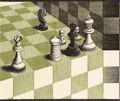mychess wrote:
The µA7805 (regulator on CC10) need 7 volts DC for supplied 5V DC.
So the transformer needed for this 7 volts DC is (7+2*0.7)/2^(1/2)=5.9 AC, not DC (0.7V are lost for each diode, and 2 are always used in a Graetz bridge).
So a 6V AC will be working.
Hi All. Slowly with all information I get from you all I getting things more clear. This is what I like… Thanks.
Now I know a uA7805 is used, I did do some temperature calculations. When the heat sink is the same as the CC10B, then I did do the assumption that the temperature resistance of this heat sink is about 7 °C/W. With the information of the datasheet I can calculate the maximum temperature allowed inside the wooden case of the Chess Challenger. At Junction temperatures of the uA7805 higher than 150°C will reduce the current (and also the output voltage) and the system will become unstable.
Here the calculations:
Current consumption 0.85 A
Tj max 150 °C
θJP of the uA7805 3 °C/W
θHA of the heat sink 7 °C/W
I did calculate with input voltages of 6V (minimum), 9V (according to spec) and 10.5Vac (as I did measure in my situation).
Total Power consumption:
@6V = 5.1VA
@9V = 7.7VA
@10.5V = 9VA
Power consumption of the power regulator
@6V = 1.8W
@9V = 5.4W
@10.5V = 7.2W
Temperature increase of the uA7805 junction (internal chip temperature) so ambient temperature has to be added to get the real temperature.
@6V = 17.7°C
@9V = 53.8°C
@10.5V = 71.8°C
Maximum allowable air temperature inside the Chess Challenger casing before the uA7805 internal temperature protection is activated.
@6V = 132.3°C
@9V = 96.2°C
@10.5V = 78.2°C
This all means that increasing the input voltage the computer will consume more power and will therefore increase the temperature inside the casing of the computer. The power regulator has to dissipate this extra heat. Therefore the maximum allowable heat sink temperature is lower. The chance that the junction temperature (chip temperature) gets higher than 150°C is increased.
Conclusion
Increasing the input voltage works two ways on the temperature. It does increase the internal air temperature and does decrease the allowable air temperature inside the chess challenger casing.
Lowering the input voltage will work two ways in the right direction.
Worth to try…
Thanks all
Kind regards Henri

